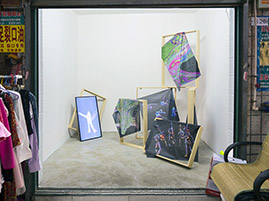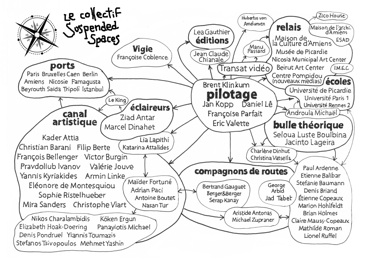Un bref article de 2006 qui pourrait très bien servir pour identifier le possible rôle que la critique pourrait jouer au sein des démarches d’exposition de Displays. Au centre on y trouve le tournant du rôle identitaire de la critique vers un rôle précaire, le critique institutionnalisé (et il l’est aussi en tant que « critique indépendant ») comme agent de la précarisation de culture. Et puis le tournant d’une politique matérielle vers une politique représentative, c’est à dire le tournant du corps aux displays – il ne s’agit des institutions culturelles d’aujourd’hui pas de bâtiment qui intègrent des écrans comme médium, mais d’institution qui sont devenues des immenses displays et dont la présences d’écrans à l’intérieur n’est que le symptôme d’une transformation profonde vers un état représentationel de l’exposition.
Source : Hito Steyerl: The Institution of Critique | eipcp.net
Étiquette : contemporary art
Bazaar Compatible Program

Beyond the White Cube and the quest for autonomy and specificity that characterized the history of modern and contemporary art, the latest practices of art are implementing strategies of infiltration, immersion and encryption. Compatibility has become the first criterion of the aesthetic of downloadables forms.
This program is designed to explore new formats compatibles now developed by the artists in a global networked culture.
Source : Bazaar Compatible Program
Suspended Spaces
Suspended spaces is an independent collective, set up above all with the desire to work together and with other artists and international researchers. It exists since 2007. It is based in Paris, Caen, Berlin.
Jan Kopp was born in 1970 in Frankfurt and lives in Paris and Rome. He is represented by the gallery Marion Meyer (Paris). He has exhibited in 2011 at the Abbey of Maubuisson and in 2012 at at the CRAC Alsace, the Fresnoy, the Collège des Bernardins (Paris), the Frac Alsace. Jacinto Lageira is a philosopher, professor in Aesthetics at the Université de Paris 1 (Panthéon-Sorbonne). Daniel Lê was born in 1961 in France, he lives in Paris. He is an artist and teaches visual arts at the Université Picardie Jules Verne (Amiens, France). Françoise Parfait is professor of visual arts and new media at the Université de Paris 1 Panthéon-Sorbonne, and an artist. Eric Valette is a lecturer in visual arts at the Université Picardie Jules Verne (Amiens, France) and an artist. He lives in Paris. websiteAre also members of the association Suspended spaces, Kader Attia, Marcel Dinahet, Maïder Fortuné, Valérie Jouve.
Source : http://www.suspendedspaces.net
L’Extension
L’Extension is an experimentation, creation and research laboratory. It seeks to place art as a ground for thought, in order to produce new experiences and establishing analytical encounter situation in terms of critical and curatorial wider activities, such as publications, meetings, events, residencies, workshops and exhibitions.Within a cartographic method, the studio aims to define the outlines of emergent art, diagnose the production process of contemporary art, working on artistic endeavour, as well as producing tools for a better understanding of artistic creation’s context by the public.Located in Belleville neighbourhood and the 20th arrondissement of Paris, L’Extension provides a platform of meetings and experiences linked to its specific environment. It also aims to fill a lack of cultural access and to bridge a various and large public to contemporary art trough many accessible activities. International protagonists’ involvement in the project enables L’Extension ambitions to reach a larger dimension.It is looking forward to yield a multidisciplinary thought imbued in different knowledge field being contemporary art, literature or history of the art, but also anthropology, economic, political, physical or social sciences…
Source : l’extension
Quand l’artiste contemporain joue au muséographe
This article deals with the intervention of contemporary artists in order to create themselves museography of exhibitions. Through the presentation of three study cases in society museums, the author shows what exhibitions language should get out of this artistic work, in both aspects of form and content – humorous, provocative or distant approach – even if the exhibition display could also be inspired by classical museal forms.



